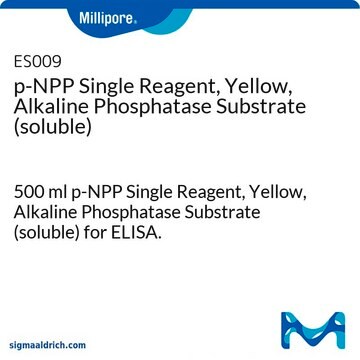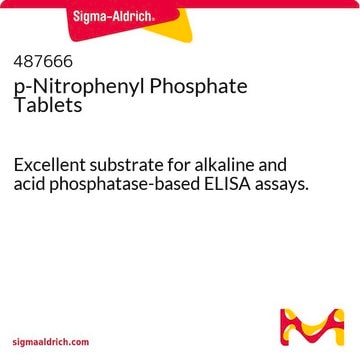N7653
p-Nitrophenyl Phosphate Liquid Substrate System
alkaline phosphatase substrate, liquid
Sinónimos:
4-Nitrophenyl phosphate disodium salt solution, pNPP
About This Item
Productos recomendados
product name
p-Nitrophenyl Phosphate Liquid Substrate System, liquid
form
liquid
shipped in
wet ice
storage temp.
−20°C
SMILES string
[Na+].[Na+].[O-][N+](=O)c1ccc(OP([O-])([O-])=O)cc1
InChI
1S/C6H6NO6P.2Na/c8-7(9)5-1-3-6(4-2-5)13-14(10,11)12;;/h1-4H,(H2,10,11,12);;/q;2*+1/p-2
InChI key
VIYFPAMJCJLZKD-UHFFFAOYSA-L
Categorías relacionadas
General description
Application
Biochem/physiol Actions
Caution
Physical form
signalword
Danger
Hazard Classifications
Eye Dam. 1 - Met. Corr. 1 - Repr. 2 - Skin Irrit. 2 - STOT RE 2 Oral
target_organs
Kidney,Liver,Blood
Storage Class
8B - Non-combustible corrosive hazardous materials
wgk_germany
WGK 3
flash_point_f
Not applicable
flash_point_c
Not applicable
Certificados de análisis (COA)
Busque Certificados de análisis (COA) introduciendo el número de lote del producto. Los números de lote se encuentran en la etiqueta del producto después de las palabras «Lot» o «Batch»
¿Ya tiene este producto?
Encuentre la documentación para los productos que ha comprado recientemente en la Biblioteca de documentos.
Los clientes también vieron
Artículos
NBT-BCIP substrate system aids in western blotting and immunohistological staining, producing a blue-purple insoluble end product.
Nuestro equipo de científicos tiene experiencia en todas las áreas de investigación: Ciencias de la vida, Ciencia de los materiales, Síntesis química, Cromatografía, Analítica y muchas otras.
Póngase en contacto con el Servicio técnico









